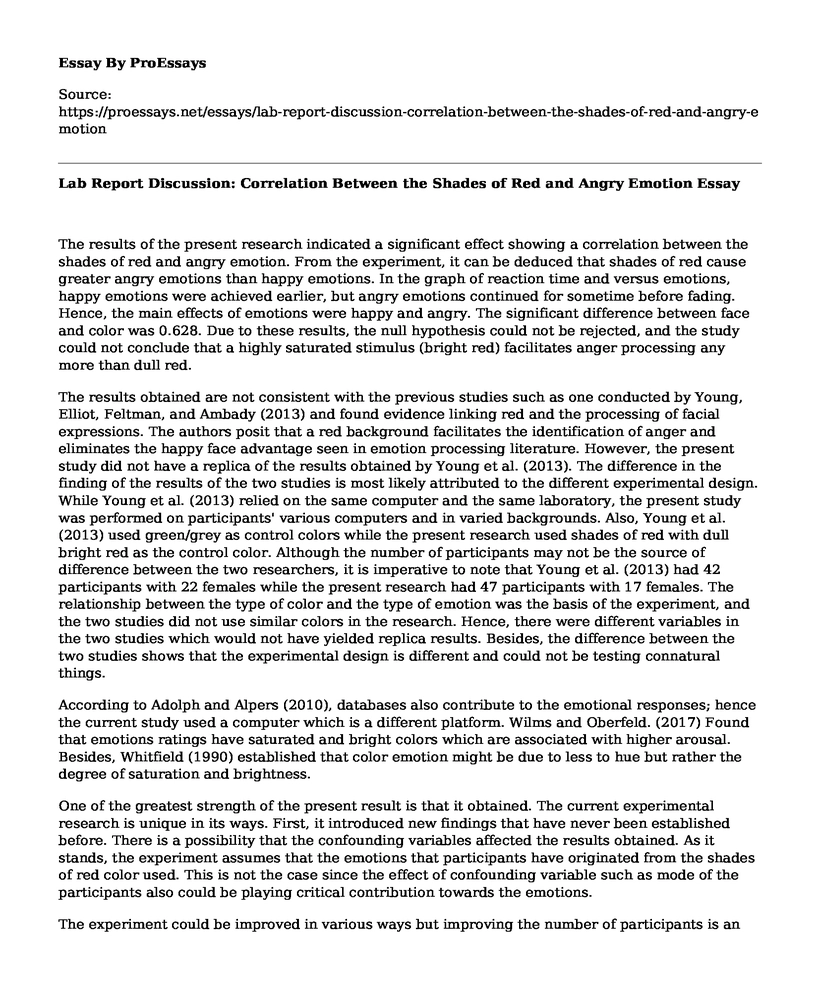The results of the present research indicated a significant effect showing a correlation between the shades of red and angry emotion. From the experiment, it can be deduced that shades of red cause greater angry emotions than happy emotions. In the graph of reaction time and versus emotions, happy emotions were achieved earlier, but angry emotions continued for sometime before fading. Hence, the main effects of emotions were happy and angry. The significant difference between face and color was 0.628. Due to these results, the null hypothesis could not be rejected, and the study could not conclude that a highly saturated stimulus (bright red) facilitates anger processing any more than dull red.
The results obtained are not consistent with the previous studies such as one conducted by Young, Elliot, Feltman, and Ambady (2013) and found evidence linking red and the processing of facial expressions. The authors posit that a red background facilitates the identification of anger and eliminates the happy face advantage seen in emotion processing literature. However, the present study did not have a replica of the results obtained by Young et al. (2013). The difference in the finding of the results of the two studies is most likely attributed to the different experimental design. While Young et al. (2013) relied on the same computer and the same laboratory, the present study was performed on participants' various computers and in varied backgrounds. Also, Young et al. (2013) used green/grey as control colors while the present research used shades of red with dull bright red as the control color. Although the number of participants may not be the source of difference between the two researchers, it is imperative to note that Young et al. (2013) had 42 participants with 22 females while the present research had 47 participants with 17 females. The relationship between the type of color and the type of emotion was the basis of the experiment, and the two studies did not use similar colors in the research. Hence, there were different variables in the two studies which would not have yielded replica results. Besides, the difference between the two studies shows that the experimental design is different and could not be testing connatural things.
According to Adolph and Alpers (2010), databases also contribute to the emotional responses; hence the current study used a computer which is a different platform. Wilms and Oberfeld. (2017) Found that emotions ratings have saturated and bright colors which are associated with higher arousal. Besides, Whitfield (1990) established that color emotion might be due to less to hue but rather the degree of saturation and brightness.
One of the greatest strength of the present result is that it obtained. The current experimental research is unique in its ways. First, it introduced new findings that have never been established before. There is a possibility that the confounding variables affected the results obtained. As it stands, the experiment assumes that the emotions that participants have originated from the shades of red color used. This is not the case since the effect of confounding variable such as mode of the participants also could be playing critical contribution towards the emotions.
The experiment could be improved in various ways but improving the number of participants is an excellent opportunity. The number of participants can be increased to feature more women who are always more color sensitive than men. Color sensitivity is an important aspect in this study and hence use of females as the participants could provide a more sensitive and accurate data than reliance on males.
The solutions to the limitations experienced in the present study can be corrected by using participants who do not influence nuisances that could affect their behaviors. This research suggests further research study on emotion recognition which relies on the same type of pattern recognition as is described for object recognition by Newen (2015).
References
Adolph, D., & Alpers, G. (2010). Valence and Arousal: A Comparison of Two Sets of Emotional Facial Expressions. The American Journal Of Psychology, 123(2), 209.
Newen, A., Welpinghus, A., & Juckel, G. (2015). Emotion Recognition as Pattern Recognition: The Relevance of Perception. Mind & Language, 30(2), 187-208.
Whitfield, T & J Wiltshire, T. (1990). Color psychology: A critical review. Genetic, social, and general psychology monographs. 116. 385-411.
Wilms, L., & Oberfeld, D. (2017). Color and emotion: effects of hue, saturation, and brightness. Psychological Research, 82(5), 896-914.
Young, S., Elliot, A., Feltman, R., & Ambady, N. (2013). Red enhances the processing of facial expressions of anger. Emotion, 13(3), 380-384. doi: 10.1037/a0032471
Cite this page
Lab Report Discussion: Correlation Between the Shades of Red and Angry Emotion. (2022, Dec 22). Retrieved from https://proessays.net/essays/lab-report-discussion-correlation-between-the-shades-of-red-and-angry-emotion
If you are the original author of this essay and no longer wish to have it published on the ProEssays website, please click below to request its removal:
- Essay on Verbal and Visual Memory
- Social Development Case Study
- Essay Example on CAPS: A Comprehensive Diagnostic Tool for PTSD
- Essay on Schizophrenia: Professional Orientation and Ethics
- Essay Sample on Treating Neurocognitive Disorder: Delirium & Its Symptoms
- Personality Disorders: Anger, Unhappiness, Isolation - Essay Sample
- The Lay of the Nightingale - Book Review Sample







